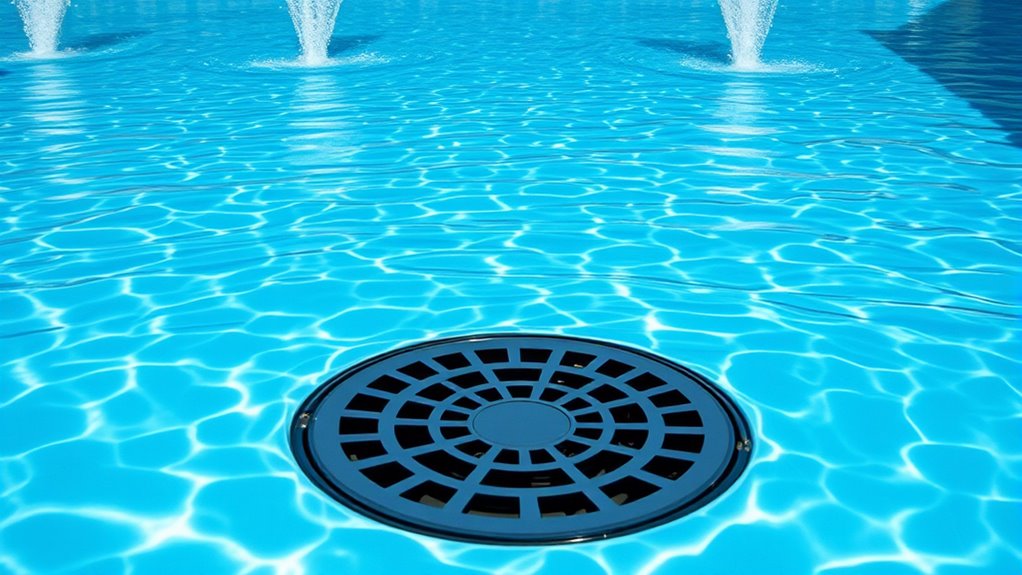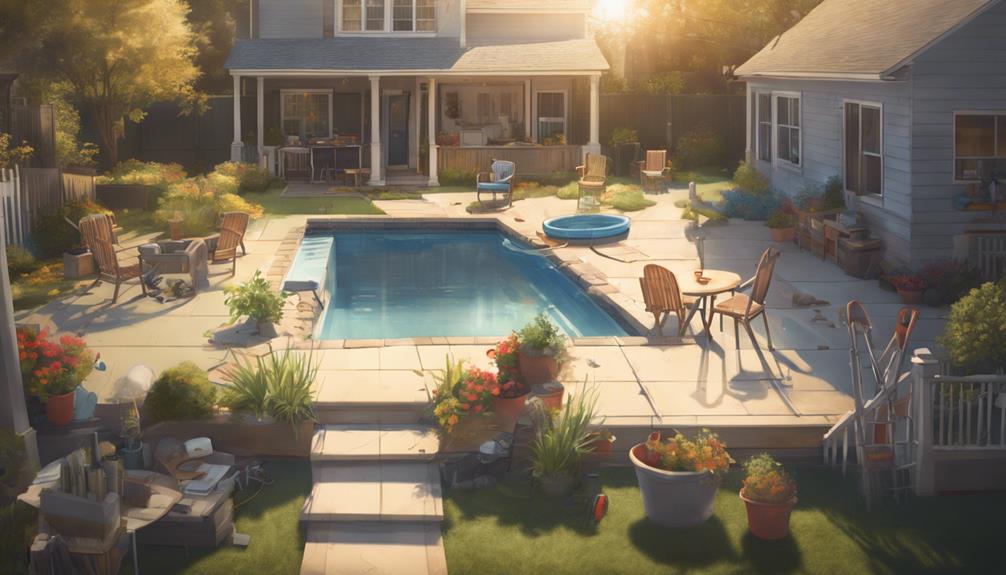To understand pool circulation, it’s important to know how skimmers, returns, and main drains work together. Skimmers collect surface debris like leaves and insects before they sink, helping keep the water clear. Returns push filtered water back into the pool, promoting even flow and chemistry balance. Main drains draw water from the bottom, preventing cold spots and ensuring uniform circulation. Keep these components functioning well to maintain a sparkling, inviting pool—there’s more to discover about their roles and how they work as a system.
Key Takeaways
- Skimmers remove floating debris and prevent clogging, improving overall water clarity and filtration efficiency.
- Returns circulate filtered water back into the pool, ensuring even distribution and preventing stagnant areas.
- Main drains draw water from the pool bottom, promoting thorough circulation and preventing cold spots or dead zones.
- All three components work together to maintain balanced water chemistry and clear, healthy pool water.
- Regular inspection and maintenance of skimmers, returns, and drains optimize circulation and extend equipment lifespan.

Have you ever wondered how pool water stays clean and clear? The secret lies in a well-designed circulation system that keeps water moving effectively through your pool. Proper circulation ensures that chemicals are evenly distributed, debris is removed, and water chemistry stays balanced. When your pool’s circulation works right, it prevents algae growth and maintains crystal-clear water. At the heart of this system are components like skimmers, returns, and main drains, each playing a crucial role in the process.
Effective pool circulation keeps water clean, clear, and balanced by distributing chemicals and removing debris.
Your skimmers are the first line of defense. Positioned at the water’s surface, they pull in floating debris such as leaves, insects, and dirt before they sink to the bottom. This not only keeps the pool looking inviting but also reduces strain on your filtration system. When skimmers operate effectively, they improve filtration efficiency by removing larger particles early on, making the entire cleaning process more efficient. Properly adjusted skimmers create a steady flow, preventing debris from settling and clogging the filters.
Returns are the outlets that push filtered water back into the pool. They distribute water evenly, promoting good circulation across every corner of your pool. When water is circulated properly, it helps maintain consistent water chemistry, making chemical balancing easier. This consistent flow prevents stagnant areas where bacteria or algae could thrive, which would otherwise compromise water quality. Adjusting the direction and flow rate of the returns can enhance circulation, ensuring that chemicals, such as chlorine and pH adjusters, mix thoroughly, maintaining a healthy swimming environment.
Main drains, located at the bottom of the pool, work in tandem with skimmers and returns. These drains pull water from the pool’s depths, helping to prevent the buildup of cold spots and dead zones where circulation might be weak. They also assist in maintaining water clarity by drawing water uniformly through your filtration system. When main drains are functioning correctly, they contribute to a balanced water chemistry, as the water is consistently circulated through the filter media, removing contaminants and particles. This constant movement keeps the water fresh and reduces the need for excessive chemical adjustments. Proper placement and maintenance of main drains are essential for optimal water circulation.
Together, skimmers, returns, and main drains form a circulation system that’s essential for a clean, inviting pool. When each component is working effectively, your pool benefits from improved water chemistry and filtration efficiency, making maintenance easier and prolonging the lifespan of your equipment. Regularly inspecting and adjusting these elements ensures efficient flow and keeps your pool sparkling, safe, and enjoyable for every swim.
Frequently Asked Questions
How Often Should I Clean My Pool’s Skimmer and Main Drain?
You should clean your skimmer and perform main drain maintenance weekly to keep your pool running smoothly. Regular skimmer cleaning removes debris before it sinks, while inspecting the main drain guarantees proper circulation and prevents clogs. By staying consistent with these tasks, you help maintain water quality, reduce strain on your pump, and extend the lifespan of your pool equipment. Make these routines a regular part of your pool care schedule.
Can I Upgrade My Pool’s Circulation System for Better Efficiency?
Yes, you can upgrade your pool’s circulation system for better efficiency. Consider pool pump upgrades to enhance water flow and energy savings. You might also explore cartridge filter options, which often require less maintenance and offer improved filtration. These upgrades help optimize circulation, reduce energy costs, and keep your pool cleaner. Consult a professional to determine the best combination for your pool’s size and specific needs.
What Are Signs of a Malfunctioning Pool Return Jet?
Think of your pool’s return jet like a faucet; if it’s malfunctioning, the water flow feels sluggish or uneven. Signs include weak or inconsistent water circulation, persistent cloudy spots, or unusual noise near the jet. A jet blockage can disrupt the entire system, making it hard to maintain clear water. Regularly check for obstructions and guarantee the jet is unobstructed to keep your pool’s flow smooth and efficient.
How Does Pool Size Affect Circulation System Design?
Your pool size directly influences your system design because larger pools need more powerful pumps and additional skimmers or returns to make certain proper circulation. Smaller pools can use simpler systems, but bigger pools require careful planning to prevent dead spots and maintain water clarity. By adjusting your system components based on pool size, you ensure efficient circulation, reduce maintenance, and keep your water clean and balanced.
Are There Eco-Friendly Options for Pool Circulation Maintenance?
You can opt for eco-friendly options like eco-friendly filtration systems and solar-powered pumps to maintain your pool. These choices help reduce energy consumption and carbon footprint, making your pool more sustainable. Solar-powered pumps harness the sun’s energy, easing operational costs and environmental impact. Eco-friendly filtration systems guarantee cleaner water while minimizing chemical use. Embracing these options allows you to enjoy your pool responsibly, with a gentle nod to the planet’s well-being.
Conclusion
Understanding your pool’s circulation system keeps it clean and inviting. Skimmers, returns, and main drains work together to circulate water efficiently, preventing debris buildup and ensuring proper filtration. Remember, a well-maintained pool is a happy pool — “A stitch in time saves nine.” By staying on top of your circulation system, you’ll enjoy sparkling water all season long. Keep it maintained, and your pool will reward you with endless enjoyment.










